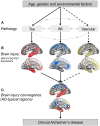Are AD-Typical Regions the Convergence Point of Multiple Pathologies?
- PMID: 25859215
- PMCID: PMC4373381
- DOI: 10.3389/fnagi.2015.00042
Are AD-Typical Regions the Convergence Point of Multiple Pathologies?
Keywords: Alzheimer’s disease; aging; amyloid; neurodegeneration; tau; vascular.
Figures

Similar articles
-
Prevention of Amyloid-β and Tau Pathologies, Associated Neurodegeneration, and Cognitive Deficit by Early Treatment with a Neurotrophic Compound.J Alzheimers Dis. 2017;58(1):215-230. doi: 10.3233/JAD-170075. J Alzheimers Dis. 2017. PMID: 28387677
-
Pittsburgh Compound B and AV-1451 positron emission tomography assessment of molecular pathologies of Alzheimer's disease in progressive supranuclear palsy.Parkinsonism Relat Disord. 2018 Mar;48:3-9. doi: 10.1016/j.parkreldis.2017.12.016. Epub 2017 Dec 13. Parkinsonism Relat Disord. 2018. PMID: 29254665 Free PMC article.
-
A novel DYRK1A (dual specificity tyrosine phosphorylation-regulated kinase 1A) inhibitor for the treatment of Alzheimer's disease: effect on Tau and amyloid pathologies in vitro.J Neurochem. 2015 May;133(3):440-51. doi: 10.1111/jnc.13018. Epub 2015 Jan 26. J Neurochem. 2015. PMID: 25556849
-
Modeling Alzheimer's disease in transgenic mice: effect of age and of presenilin1 on amyloid biochemistry and pathology in APP/London mice.Exp Gerontol. 2000 Sep;35(6-7):831-41. doi: 10.1016/s0531-5565(00)00149-2. Exp Gerontol. 2000. PMID: 11053674 Review.
-
Dissecting the Contribution of Vascular Alterations and Aging to Alzheimer's Disease.Mol Neurobiol. 2016 Aug;53(6):3793-3811. doi: 10.1007/s12035-015-9319-7. Epub 2015 Jul 5. Mol Neurobiol. 2016. PMID: 26143259 Review.
Cited by
-
Divergent regional patterns of cerebral hypoperfusion and gray matter atrophy in mild cognitive impairment patients.J Cereb Blood Flow Metab. 2017 Mar;37(3):814-824. doi: 10.1177/0271678X16641128. Epub 2016 Jul 20. J Cereb Blood Flow Metab. 2017. PMID: 27037094 Free PMC article.
-
Identification of critical genes and drug repurposing targets in entorhinal cortex of Alzheimer's disease.Neurogenetics. 2025 Feb 10;26(1):27. doi: 10.1007/s10048-025-00806-x. Neurogenetics. 2025. PMID: 39928227
-
Arterial spin labelling reveals multi-regional cerebral hypoperfusion in patients with transient ischemic attack that are unrelated to ischemia location: A proof-of-concept study.Cereb Circ Cogn Behav. 2023 Apr 13;4:100164. doi: 10.1016/j.cccb.2023.100164. eCollection 2023. Cereb Circ Cogn Behav. 2023. PMID: 37124951 Free PMC article.
-
Tau and the fractionated default mode network in atypical Alzheimer's disease.Brain Commun. 2022 Mar 9;4(2):fcac055. doi: 10.1093/braincomms/fcac055. eCollection 2022. Brain Commun. 2022. PMID: 35356035 Free PMC article.
-
Contribution of Alzheimer's biomarkers and risk factors to cognitive impairment and decline across the Alzheimer's disease continuum.Alzheimers Dement. 2022 Jul;18(7):1370-1382. doi: 10.1002/alz.12480. Epub 2021 Oct 14. Alzheimers Dement. 2022. PMID: 34647694 Free PMC article.
References
Publication types
LinkOut - more resources
Full Text Sources
Other Literature Sources

